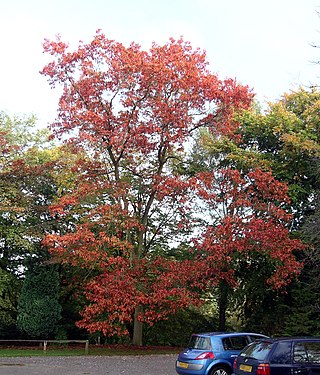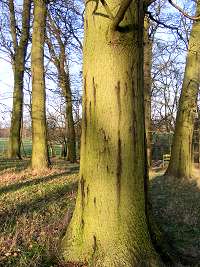Related Research Articles

Quercus rubra, the northern red oak, is an oak tree in the red oak group. It is a native of North America, in the eastern and central United States and southeast and south-central Canada. It has been introduced to small areas in Western Europe, where it can frequently be seen cultivated in gardens and parks. It prefers good soil that is slightly acidic. Often simply called red oak, northern red oak is so named to distinguish it from southern red oak (Q. falcata), also known as the Spanish oak. Northern red oak is sometimes called champion oak.

Quercus petraea, commonly known as the sessile oak, Cornish oak, Irish Oak or durmast oak, is a species of oak tree native to most of Europe and into Anatolia and Iran. The sessile oak is the national tree of Ireland, and an unofficial emblem in Wales and Cornwall.

A plant canker is a small area of dead tissue, which grows slowly, often over years. Some cankers are of only minor consequence, but others are ultimately lethal and therefore can have major economic implications for agriculture and horticulture. Their causes include a wide range of organisms as fungi, bacteria, mycoplasmas and viruses. The majority of canker-causing organisms are bound to a unique host species or genus, but a few will attack other plants. Weather and animal damage can also cause stress to the plant resulting in cankers. Other causes of cankers is pruning when the bark is wet or using un-sterilized tools.
Brenneria salicis is a Gram-negative bacterium that is pathogenic on plants.

Phytophthora kernoviae is a plant pathogen that mainly infects European beech and Rhododendron ponticum. It was first identified in 2003 in Cornwall, UK when scientists were surveying for the presence of Phytophthora ramorum. This made it the third new Phytophthora species to be found in the UK in a decade. It was named Phytophthora kernoviae after the ancient name for Cornwall, Kernow. It causes large stem lesions on beech and necrosis of stems and leaves of Rhododendron ponticum. It is self-fertile. It has also been isolated from Quercus robur and Liriodendron tulipifera. The original paper describing the species, stated it can infect Magnolia and Camellia species, Pieris formosa, Gevuina avellana, Michelia doltsopa and Quercus ilex. Since then many other plants have been identified as natural hosts of the pathogen. Molecular analysis has revealed that an infection on Pinus radiata, recorded in New Zealand in 1950, was caused by P. kernoviae. The pathogen was also noted on Drimys winteri, Gevuina avellana, Ilex aquifolium, Quercus ilex, Vaccinium myrtillus, Hedera helix, Podocarpus salignas.

Acute oak decline (AOD) is a disease that infects oak trees originally described in the UK. It mainly affects mature oak trees of over 50 years old of both Britain's native oak species: the pedunculate oak and the sessile oak. The disease is characterised by the trees bleeding or oozing a dark fluid from small lesions or splits in their bark. Unlike chronic oak decline, acute oak decline can lead to the death of trees within 4 to 5 years of symptoms appearing. The number of trees affected is thought to number in the low thousands, with a higher number of infected trees being found in the Midlands.
Methylorubrum populi is an aerobic, pink-pigmented, facultatively methylotrophic, methane-utilizing bacterium isolated from poplar trees. Its type strain is BJ001T.

Agrilus biguttatus is a species of beetle in the family Buprestidae, the jewel beetles. Common names include oak splendour beetle, oak buprestid beetle, and two-spotted oak borer. This beetle is known as a pest that causes damage to oak trees and is a major factor in oak decline.
Acinetobacter puyangensis is a Gram-negative, rod-shaped and non-motile bacterium from the genus Acinetobacter which has been isolated from the bark of the tree Populus x euramericana.
Acinetobacter qingfengensis is a Gram-negative, rod-shaped and non-motile bacterium from the genus Acinetobacter which has been isolated from the bark of the tree Populus x euramericana.
Microbacterium populi is a Gram-positive, non-spore-formin and aerobic bacterium from the genus Microbacterium which has been isolated from the bark of Populus × euramericana.
Acinetobacter populi is a bacterium from the genus of Acinetobacter which has been isolated from a canker of the tree Populus x euramericana in Puyang in China.
Niastella is a bacterial genus from the family of Chitinophagaceae.
Corticibacterium is a genus of bacteria from the family Phyllobacteriaceae with one known species.
Corticibacterium populi is a Gram-negative, aerobic and motile bacterium from the genus of Corticibacterium which has been isolated from the bark Populus × euramericana.
Sphingobacterium populi is a Gram-negative, aerobic and non-motile bacterium from the genus of Sphingobacterium which has been isolated from the bark of the tree Populus × euramericana.
Wohlfahrtiimonas populi is a Gram-negative, facultatively anaerobic and motile bacterium from the genus of Wohlfahrtiimonas which has been isolated from tree Populus × euramericana.
Flavitalea populi is a Gram-negative, rod-shaped, aerobic and non-motile bacterium from the genus of Flavitalea which has been isolated from soil from the plant Populus euphratica from a forest in Xinjiang in China.
Streptomyces populi is an endophytic bacterium species from the genus of Streptomyces which has been isolated from the stem of the tree Populus adenopoda from the Mount Qingcheng in China.

Snodgrassella alvi is a species of Gram-negative bacteria within the Neisseriaceae and was previously the only known species of the genus Snodgrassella. It was isolated and scientifically described in 2012 by Waldan K. Kwong and Nancy A. Moran, who named the bacteria after the American entomologist Robert Evans Snodgrass.
References
- ↑ Phylogenetic Position of Phytopathogens within the Enterobacteriaceae. Hauben et al, 1998. doi:10.1016/S0723-2020(98)80048-9
- ↑ Toth, Ian K.; Bell, Kenneth S.; Holeva, Maria C.; Birch, Paul R. J. (1 January 2003). "Soft rot erwiniae: from genes to genomes". Molecular Plant Pathology. 4 (1): 17–30. doi:10.1046/j.1364-3703.2003.00149.x. PMID 20569359.
- ↑ McClean, Ali E.; Sudarshana, Padma; Kluepfel, Daniel A. (2008-05-06). "Enhanced detection and isolation of the walnut pathogen Brenneria rubrifaciens, causal agent of deep bark canker". European Journal of Plant Pathology. 122 (3): 413–424. doi:10.1007/s10658-008-9308-z. ISSN 0929-1873.
- ↑ Denman, Sandra; Brown, Nathan; Kirk, Susan; Jeger, Mike; Webber, Joan (2014-10-01). "A description of the symptoms of Acute Oak Decline in Britain and a comparative review on causes of similar disorders on oak in Europe". Forestry. 87 (4): 535–551. doi: 10.1093/forestry/cpu010 . ISSN 0015-752X.
- ↑ Denman, Sandra; Doonan, James; Ransom-Jones, Emma; Broberg, Martin; Plummer, Sarah; Kirk, Susan; Scarlett, Kelly; Griffiths, Andrew R; Kaczmarek, Maciej (2017-10-13). "Microbiome and infectivity studies reveal complex polyspecies tree disease in Acute Oak Decline". The ISME Journal. 12 (2): 386–399. doi:10.1038/ismej.2017.170. ISSN 1751-7362. PMC 5776452 . PMID 29028005.
- ↑ Palomo-Ríos, Elena; Macalpine, William; Shield, Ian; Amey, Joanna; Karaoğlu, Cuma; West, Jevon; Hanley, Steven; Krygier, Richard; Karp, Angela (November 2015). "Efficient method for rapid multiplication of clean and healthy willow clones via in vitro propagation with broad genotype applicability". Canadian Journal of Forest Research. 45 (11): 1662–1667. doi:10.1139/cjfr-2015-0055. hdl: 1807/69847 . ISSN 0045-5067.
- ↑ SURICO, GIUSEPPE; MUGNAI, LAURA; PASTORELLI, ROBERTA; GIOVANNETTI, LUCIANA; STEAD, DAVID E. (1996). "Erwinia alni, a New Species Causing Bark Cankers of Alder (Alnus Miller) Species". International Journal of Systematic and Evolutionary Microbiology. 46 (3): 720–726. doi: 10.1099/00207713-46-3-720 .
- ↑ Loreti, S.; De Simone, D.; Gallelli, A. (August 2008). "Detection and Identification ofBrenneria nigrifluens, the Causal Agent of the Shallow Bark Canker of Walnut by, PCR Amplification". Journal of Phytopathology. 156 (7–8): 464–469. doi:10.1111/j.1439-0434.2007.01393.x. ISSN 0931-1785.
- ↑ Li, Yong; Fang, Wei; Xue, Han; Liang, Wen-xing; Wang, Lai-fa; Tian, Guo-zhong; Wang, Xi-zhuo; Lin, Cai-li; Li, Xia (2015). "Brenneria populi sp. nov., isolated from symptomatic bark of Populus×euramericana canker". International Journal of Systematic and Evolutionary Microbiology. 65 (2): 432–437. doi: 10.1099/ijs.0.066068-0 . PMID 25385993.
- ↑ Li, Yong; Zheng, Ming-hui; Wang, Hai-ming; Lin, Cai-li; Wang, Xi-zhuo (2018). "Brenneria corticis sp. nov., isolated from symptomatic bark of Populus×euramericana canker". International Journal of Systematic and Evolutionary Microbiology. 69 (1): 63–67. doi: 10.1099/ijsem.0.003077 . ISSN 1466-5026. PMID 30403583.
- 1 2 Brady, Carrie; Hunter, Gavin; Kirk, Susan; Arnold, Dawn; Denman, Sandra (September 2014). "Description of Brenneria roseae sp. nov. and two subspecies, Brenneria roseae subspecies roseae ssp. nov and Brenneria roseae subspecies americana ssp. nov. isolated from symptomatic oak". Systematic and Applied Microbiology. 37 (6): 396–401. doi:10.1016/j.syapm.2014.04.005. ISSN 0723-2020. PMID 24917366.